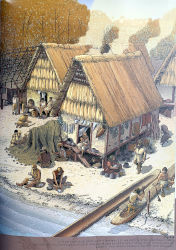The richly documented and illustrated work La Préhistoire du Jura et l’Europe néolithique en 100 mots-clés (Prehistory of the Jura and Neolithic Europe in 100 key words) by Pierre and Anne-Marie Pétrequin , published by Presses universitaires de Franche-Comté in the Cahiers de la MSHE Claude Nicolas Ledoux collection, takes a look back on forty-five years of archaeological research in the Jura. With this general survey published in June 2021, readers can retrace the history of the first farmers between 5300 and 2400 BCE.
Prehistory of the Jura and
Neolithic Europe in 100 key words
The work itself
Trained in ethnoarchaeology in New Guinea, the work’s authors offer an original reading of the historical trajectory of the first farming communities between 5300 and 2400 BCE, when microregions – here, the Jura and Saône valley – were deeply linked to complex systems of movement of objects and ideas. Within prehistoric Western Europe, these long-distance movements were fueled by social competition, discrimination and religion. One hundred key words from the archaeological vocabulary allow us to explore different social interpretations hidden behind the objects and behaviors of Neolithic populations. Published with support from the Regional Office of Cultural Affairs Burgundy Franche-Comté (Direction régionale des affaires culturelles Bourgogne Franche-Comté), the Ain Valley Archaeological Center (Centre archéologique de la vallée de l’Ain) and the Center for Human and Environmental Sciences Claude Nicolas Ledoux (Maison des sciences de l’homme et de l’environnement Claude Nicolas Ledoux), the publication consists of three richly illustrated volumes that reveal complex Neolithic societies throughout Western Europe. It is a magnificent work that will delight both specialists in these geographical areas and archaeologists interested in ethnoarchaeology.
Methodology used
The one hundred key words constitute the backbone of the three volumes and structure the book. The authors begin with an introduction dealing with the development of knowledge about the European Neolithic era between the years of 1835 and 1970, before presenting their own approach and a historical overview of the societies of the time. They then go through each key word, chapter by chapter. In this way, the authors take us through different aspects of these societies, ones ranging from material to spiritual, starting with pottery, clothes, environments, cuisine, etc., up through symbolic aspects, with symbols of power, beliefs and the concept of death. Each chapter is richly illustrated with maps, diagrams, reconstructions, samples of materials, and graphics that allow us to go beyond the text.
The authors
Anne-Marie Pétrequin and Pierre Pétrequin are ethnoarchaeologists specializing in the Neolithic era, emeritus research directors at the CNRS and members of MSHE Claude Nicolas Ledoux in Besançon. Pierre Pétrequin led excavations near Lac de Chalain and Lacs de Clairvaux (Jura) from 1970 to 2008, as well as an ethnoarchaeological project in New Guinea. Their research then led them to focus on the development and spread of large Alpine axes dating from the European Neolithic period. They received the National Archaeology Prize in 1992 for their work on the Neolithic coastal habitats of the French Jura, the CNRS Silver Medal in 1993 for their ethnoarchaeological work, and the Europa Prize in 2010 from the Prehistoric Society for their work on Alpine axes across Europe.
Pierre Pétrequin and Anne-Marie Pétrequin, La Préhistoire du Jura et l’Europe néolithique en 100 mots-clés, Presses universitaires de Franche-Comté n°1500, Les Cahiers de la MSHE Ledoux n°44, Centre archéologique de la vallée de l’Ain n°45, June 2021. 1938 pages over 3 volumes, illustrated with photographs and diagrams. Format: 21 x 29.7 cm ISBN: 978-2-84867-846-7 / ISSN: 1772-6220 Price (with tax): €133 on the publisher’s website. Genre: Scientific documentary – publication
See the table of contents for the 3 volumes on Maison des Sciences de l’Homme et de l’Environnement Claude Nicolas Ledoux’s website – and an introduction to the book.
ArkéoTopia’s opinion
Additional reading in French
- Interview with the researchers about the book during an interview at Maison des Sciences de l’Homme et de l’Environnement Claude Nicolas Ledoux
- Interview with Pierre Pétrequin by Robin Furestier, “Rencontre avec Pierre Pétrequin,” Ardèche Archéologie, 38, 2021, pp. 86-94
- Discover d’other works by Anne-Marie Pétrequin and other works by Pierre Pétrequin
Let us know what you think by leaving a comment on
ArkeoTopia’s Facebook page ou le ArkeoTopia’s Twitter page
If you would like us to review a book, documentary or other archaeology-related work for children or adults, please let us know with this form.
ArkeoTopia, an alternative approach to archaeology® aims to take a different look at current archaeology to better help existing organizations prepare for tomorrow.
To find out more about the association, watch our introductory video and read about what we do.








